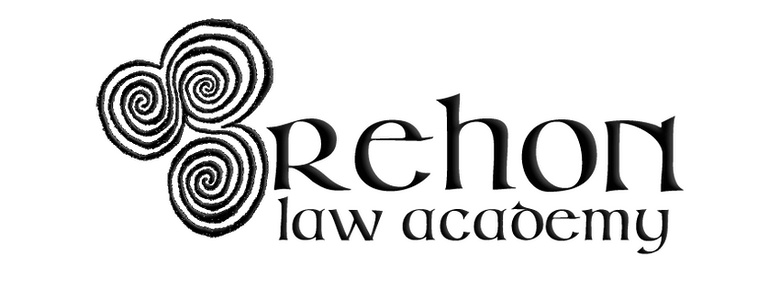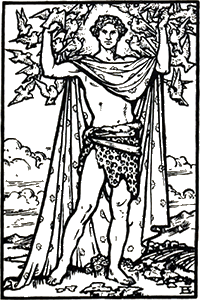Aengus was one of the illustrious and mysterious Tuatha Dé Danann, a mystical race of beings who came to Ireland in the distant past bringing high culture along with them.
In the course of time, this Tuatha were raised to the status of gods and goddesses; though it should be said that the conception of the divine was quite different in early pagan Ireland from what we are familiar with today.
The name Aengus (also Aongus, Óengus, Angus) can be translated to mean ‘chosen one’, from aon, meaning ‘one’, and gus, meaning ‘choice’, or literally ‘one-choice’, the ‘chosen one’.
The óg part of his name means young or youthful; think of the magical land of the faeries called Tír na nÓg, the ‘land of the ever-young’.
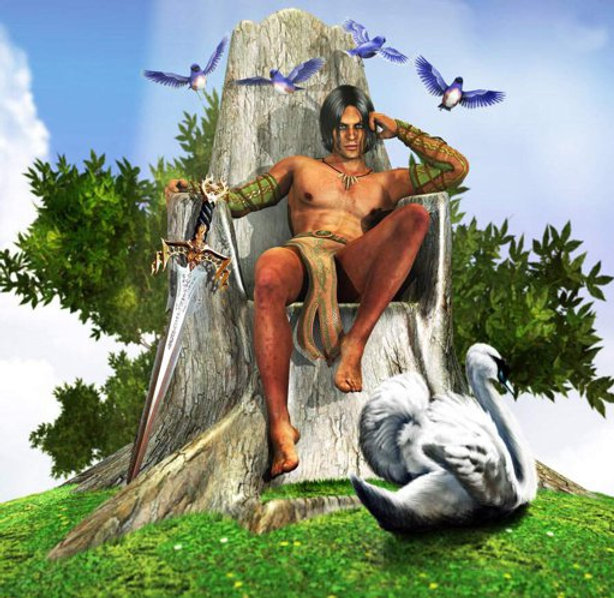
Aengus was son of the Dagda – the father-god of the Tuatha De Danann – and he was both conceived and born on the same day due to some magical spells cast by the Dagda.
In this way, he is the archetypical youth, man in a perpetual springtime of life.
Aengus had a magical harp which could create an irresistible attraction to all who heard it.
Birds were said to represent Aengus’ kisses and it is written that four magical birds hovered around his head. These birds, Aengus’ kisses, were believed to carry messages of love on Aengus’ behalf as he sang love and played beautiful music into the hearts of the young.
Ireland’s Greatest Love Story: Diarmuid and Grainne
Aengus is also said to have been the protector and guardian of Diarmuid and Grainne; a mythical couple from one of our most tragic romance tales. The story takes place during the Fenian Cycle of Irish myth.
Grainne was the daughter of the High King Cormac MacAirt, her stunning beauty was legendary across the island. Many high ranking nobles and chieftains tried in vain to secure her hand in marriage.
Enter our familiar hero, Fionn MacCool, leader of the Fianna warriors. At the time of the telling of the tale, Fionn is an aged man in the latter stage of life. He sought to marry Grainne and make her is second wife.
Being who he was; the mighty Fionn of the Fianna who ate of the salmon of knowledge and whose feats had been immortalised by the great bards, Grainne agrees to marry him.
A great celebratory feast was held to honour the soon-to-be wedded couple. However, fate would have a hand in events that night, for it was here that Grainne and Diarmuid first laid eyes on each other.
Diarmuid was a young warrior, one of Fionn’s best fighters, handsome and strong, loyal.
Grainne was instantly entralled, she craved him and knew in that moment that she loved him. She knew in her heart that Diarmuid, not Fionn, was the right man for her and she decided to be with him.
To get Diarmuid alone to herself she drugged the entire congregation with a magical potion sending all into a deep slumber. All except Diarmuid.
Alone, Grainne confesses her love for him but the loyal warrior refused to betray is leader, teacher, and friend, Fionn. This did not stop Grainne who was determined to get the man she truly wanted to be with. So she cast a spell on Diarmuid who falls deeply in love with her.
The young couple depart the assembly under the cover of darkness and begin a life on the run.
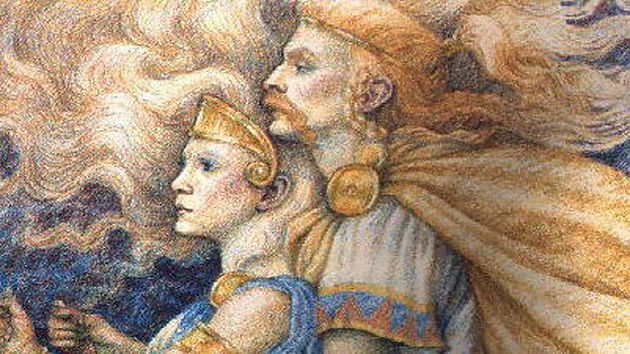
Furious, Fionn and his men pursue the lovers across the island, but, helped by the young love god Aengus Óg, they remain elusive by making use of Irelands nooks, crooks, caves, trees, and crannies.
Traversing the island trying to avoid capture by Fionn and his Fianna warriors, running by day, sleeping under stars by night, using dolmens as their nightly bed, Aengus Óg gifted Diarmuid with a sword, advised the lovers on the best paths to follow and used his protective cloak to help the fated couple avoid detection.
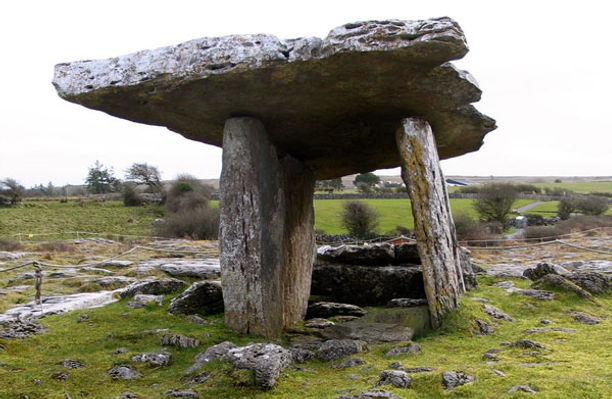
They evaded capture for many years, but live like fugitives in their own lands. Always hiding, always moving, always in love with one another. After a time Grainne becomes pregnant with Diarmuid’s child.
But they couldn’t run forever, soon they would be confronted with the consequences of their actions when Fionn’s men finally finds them.
It had been prophesised that the boar was the only animal that would cause Diarmuid harm and that he should be weary around them. When they are confronted by a boar while crossing Benbulben in Co. Sligo, and with Fionn’s warriors closing in on them, they were panicked.
Diarmuid tried to kill the boar and protect his lover and unborn child by wrestling it to the ground as it charged for him. Diarmuid drove the sword which had been given to him by Aengus into the flesh of the boar, but not before it managed gorge a deep wound into Diarmuid. A wound that would be fatal.
Fionn and his warriors find Diarmuid and Grainne in this state. Grainne holds her dying lover in her arms, her robes covered in blood as she cries out for mercy. She reminds Fionn of the closeness of the friendship he an Diarmuid once enjoyed and begged Fionn to save him by allowing Diarmuid drink water from Fionn’s magical hands (remember, Fionn burned his finger on the Salmon of Knolwedge and gained magical abilities).
Fionn, stubborn and ignorant, bitterly refuses to listen to Grainne’s pleas. Diarmuid’s comrades of the Fianna could not stand to watch one of their own suffer like this, despite his wrongdoings, and they begin to emplore Fionn to help.
It is only when Fionn’s son Oisin challenges his father to fight if he does not help Diarmuid that Fionn acquiesces. Cupping his hands at a nearby stream, Fionn ran to Diarmuid but, alas, it was too little too late.
Diarmuid had died and Grainne was devastated.
Aengus Falls in Love
The young love god Aengus was not impervious to pangs of the heart himself, however.
Another of Ireland’s great love stories is called Aisling Óengus, or the Dream of Aengus, and it describes the painful, unrequited love for a woman who began appearing to Aengus every night as a vision in a dream.
You can read the full tale here on the Brehon Law Academy blog, what follows is a short but sweet summary.
Stricken by her beauty, yet unable to touch her or even know who she was, Aengus is tormented by the woman in his visions and is found pining for this love he thinks he will never know.
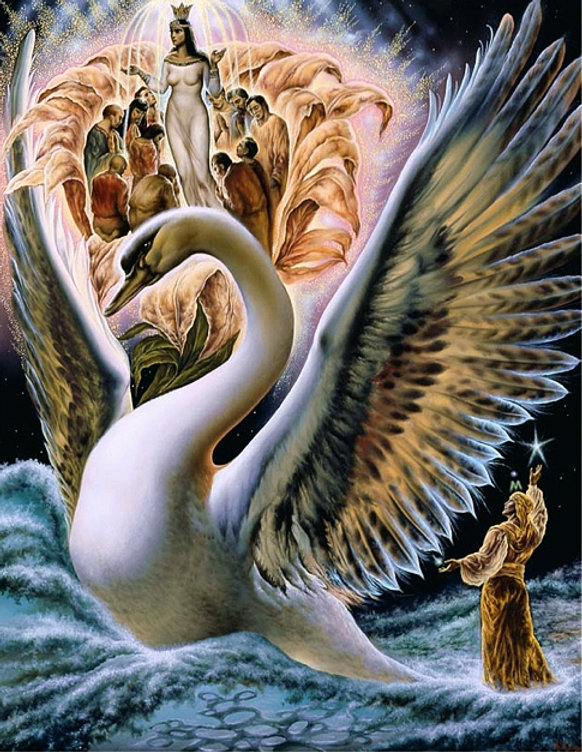
His youthful vibrancy begins to wane, his health deteriorated and he begins to slowly die of a pinaful heart.
Desperate, he calls on his parents for help; his father the Dagda and mother Bionn (or Boann, the goddess for whom the Boyne River is named).
The Dagda called on the assistance of Bov the Red, another of the Tuatha De Danann, a powerful sidhe who also makes an appearance in the classic tale of the Children of Lír.
Bov is charged with searching all of Ireland in an effort to locate the mysterious maiden of Aengus’ dreams.
Still confined to his sick-bed, Aengus sits and waits helplessly for Bov’s return for an entire year.
His waiting was not in vain, as Bov returns with promising news that he had finally located the woman of Aengus’ dreams at the Lake of the Dragons Mouth.
Aengus wastes no more time and sets off immediately for the Lake of the Dragons Mouth. Arriving at the lake, he comes upon one hundred fifty beautiful maidens with hair tied up in golden chains.
This was no issue for Aengus, however, who has no trouble identifying the woman of his dreams among the crowd because she was tallest.
Her name was Caer.
Caer was the daughter of yet another powerful sídhe by the name of Ethel who refused to allow her daughter be taken away by the overly amorous Aengus.
Bov then sought the help of Meadbh and Ailill, queen and king of Connaught (we know these characters from the Táin epic in the Ulster Cycle of Irish myth), in the hopes that they might persuade Ethel to change her mind. But to no avail.
Ethel is then taken hostage by Ailill and the Dagda who try once more to demand Ethel handover Caer, but they fail once more because she was too powerful.
Aengus learns that the woman he loves is herself a mystical maiden who transforms into a swan on the first day of November (Samháin).
Aengus travels to the Lake of the Dragon’s Mouth on the 1st of November where he sees one hundred fifty swans enjoying their own majesty. Here, standing on the banks of the lake, Aengus cries out to his love Caer and confesses the depths of his heart and feelings to her.
Aengus is then magically transformed into a beautiful swan and the lovers, finally together, fly across the land towards Aengus’ palace Brú na Boyne (this is the Newgrange mound in the Boyne Valley).
As the pair flew, they were accompanied by a sweet fairy music so beautiful and enchanting that it lulled all who heard it to sleep for three days and three nights.
There are more stories about Aengus, but these are the main ones that relate to him as a youthful god of love. Check out the Brehon Law Academy’s video which tells the tale of ‘The Taking of the Fairy Mound’ which shows Aengus to be cunning as well as devastatingly romantic.
Aengus’ archetype reminds us of the sometimes enrapturing sometimes earth-shattering feelings of young love and of love at any costs.
__________________________________
Learn all about Ireland’s Four-Cycles of Mythology in the Brehon Law Academy’s online course “Irish Mythology” http://bit.ly/irishmythcourse
Get access here for only 14.99 (50%) thru February 2020. Purchase now and get lifetime access.
__________________________________
